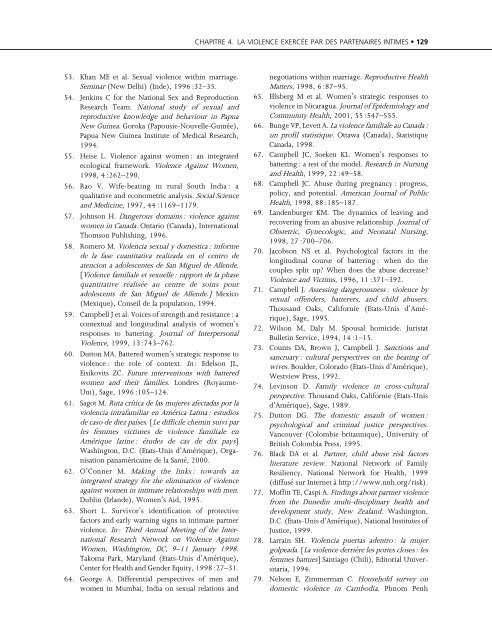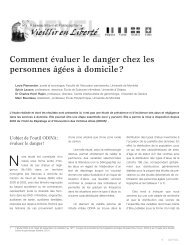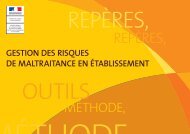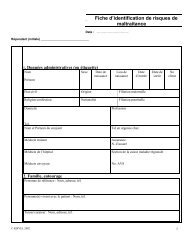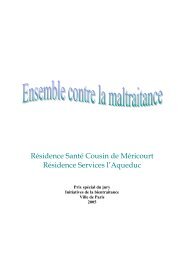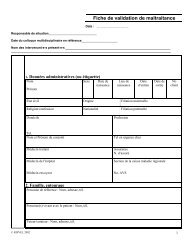128 . RAPPORT MONDIAL SUR LA VIOLENCE ET LA SANTÉ26. Fox JA, Zawitz MW. Homicide trends in the UnitedStates. Washington, D.C. (Etats-Unis d’Amérique),Bureau of Justice Statistics, United States Departmentof Justice, 1999.27. Carcach C, James M. Homicide b<strong>et</strong>ween intimatepartners in Australia. Canberra (Australie), AustralianInstitute of Criminology, 1998.28. When men murder women : an analysis of 1996homicide data. Washington, D.C. (Etats-Unisd’Amérique), Violence Policy Center, 2000.29. Karkal M. How the other half dies in Bombay.Economic and Political Weekly,24 août 1985 :1424.30. Mercy JA <strong>et</strong> al. Intentional injuries. In : Mashaly AY,Graitcer PL, Youssef ZM. Injury in Egypt : ananalysis of injuries as a health problem. Le Caire(Egypte), Rose El Youssef New Presses, 1993.31. Johnson MP. Patriarchal terrorism and commoncouple <strong>violence</strong> : two forms of <strong>violence</strong> againstwomen. Journal of Marriage and the Family, 1995,57 :283–294.32. Johnson MP, Ferraro KJ. Research on domestic<strong>violence</strong> in the 1990s : making distinctions. Journalof Marriage and the Family, 2000, 62 :948–963.33. Kantor GK, Jasinski JL. Dynamics and risk factors inpartner <strong>violence</strong>. In : Jasinski JL, Williams LM.Partner <strong>violence</strong> : a comprehensive review of 20years of research. Thousand Oaks, Californie (Etats-Unis d’Amérique), Sage, 1998.34. Morse BJ. Beyond the conflict tactics scale : assessinggender differences in partner <strong>violence</strong>. Violence andVictims, 1995, 10 :251–272.35. Brush LD. Violent acts and injurious outcomes inmarried couples : m<strong>et</strong>hodological issues in thenational <strong>sur</strong>vey of family and households. Genderand Soci<strong>et</strong>y, 1990, 4 :56–67.36. Centre canadien de <strong>la</strong> statistique juridique. La<strong>violence</strong> familiale au Canada : un profil statistique.Ottawa (Canada), Statistique Canada, 2000.37. Saunders DG. When battered women use <strong>violence</strong> :husband-abuse or self-defense? Violence and Victims,1986, 1 :47–60.38. DeKeseredy WS <strong>et</strong> al. The meanings and motives forwomen’s use of <strong>violence</strong> in Canadian college datingre<strong>la</strong>tionships : results from a national <strong>sur</strong>vey.Sociological Spectrum, 1997, 17 :199–222.39. Schuler SR <strong>et</strong> al. Credit programs, patriarchy andmen’s <strong>violence</strong> against women in rural Bang<strong>la</strong>desh.Social Science and Medicine, 1996, 43 :1729–1742.40. Zimmerman K. P<strong>la</strong>tes in a bask<strong>et</strong> will rattle :domestic <strong>violence</strong> in Cambodia : A summary.Phnom Penh (Cambodge), Project Against DomesticViolence, 1995.41. Michau L. Community-based research for socialchange in Mwanza, Tanzania. In : Third AnnualMe<strong>et</strong>ing of the International Research N<strong>et</strong>work onViolence Against Women, Washington, DC, 9–11January 1998. Takoma Park, Mary<strong>la</strong>nd (Etats-Unisd’Amérique), Center for Health and Gender Equity,1998 :4–9.42. Armstrong A. Culture and choice : lessons from<strong>sur</strong>vivors of gender <strong>violence</strong> in Zimbabwe. Harare(Zimbabwe), Violence Against Women in ZimbabweResearch Project, 1998.43. Gonzalez Montes S. Domestic <strong>violence</strong> in Cu<strong>et</strong>za<strong>la</strong>n,Mexico : some research questions and results. In :Third Annual Me<strong>et</strong>ing of the International ResearchN<strong>et</strong>work on Violence Against Women, Washington,DC, 9–11 January 1998. Takoma Park,Mary<strong>la</strong>nd (Etats-Unis d’Amérique), Center forHealth and Gender Equity, 1998 :36–41.44. Osakue G, Hilber AM. Women’s sexuality andfertility in Nigeria. In : P<strong>et</strong>chesky R, Judd K.Negotiating reproductive rights. Londres (Royaume-Uni),Zed Books, 1998 :180–216.45. Hassan Y. The haven becomes hell : a study ofdomestic <strong>violence</strong> in Pakistan. Lahore (Pakistan),Shirkat Gah Women’s Resource Centre, 1995.46. Bradley CS. Attitudes and practices re<strong>la</strong>ting tomarital <strong>violence</strong> among the To<strong>la</strong>i of East NewBritain. In : Domestic <strong>violence</strong> in Papua NewGuinea. Boroko (Papousie-Nouvelle-Guinée), PapuaNew Guinea Law Reform Commission,1985 :32–71.47. Jejeebhoy SJ. Wife-beating in rural India : ahusband’s right? Economic and Political Weekly,1998, 33 :855–862.48. El-Zanaty F <strong>et</strong> al. Egypt demographic and health<strong>sur</strong>vey 1995. Calverton, Mary<strong>la</strong>nd (Etats-Unisd’Amérique), Macro International, 1996.49. Rosales J <strong>et</strong> al. Encuesta Nicaraguense de demografiay salud, 1998. [Enquête démographique <strong>et</strong> sanitairenicaraguayenne, 1998.] Managua (Nicaragua),Instituto Nacional de Estadisticas y Censos, 1999.50. David F, Chin F. Economic and psychosocialinfluences of family p<strong>la</strong>nning on the lives of womenin Western Visayas. Iloilo (Philippines), CentralPhilippines University and Family Health International,1998.51. Bawah AA <strong>et</strong> al. Women’s fears and men’s anxi<strong>et</strong>ies :the impact of family p<strong>la</strong>nning on gender re<strong>la</strong>tions innorthern Ghana. Studies in Family P<strong>la</strong>nning, 1999,30 :54–66.52. Wood K, Jewkes R. Violence, rape, and sexualcoercion : everyday love in a South Africantownship. Gender and Development, 1997, 5 :41-46.
CHAPITRE 4. LA VIOLENCE EXERCÉE PAR DES PARTENAIRES INTIMES . 12953. Khan ME <strong>et</strong> al. Sexual <strong>violence</strong> within marriage.Seminar (New Delhi) (Inde), 1996 :32–35.54. Jenkins C for the National Sex and ReproductionResearch Team. National study of sexual andreproductive knowledge and behaviour in PapuaNew Guinea. Goroka (Papousie-Nouvelle-Guinée),Papua New Guinea Institute of Medical Research,1994.55. Heise L. Violence against women : an integratedecological framework. Violence Against Women,1998, 4 :262–290.56. Rao V. Wife-beating in rural South India : aqualitative and econom<strong>et</strong>ric analysis. Social Scienceand Medicine, 1997, 44 :1169–1179.57. Johnson H. Dangerous domains : <strong>violence</strong> againstwomen in Canada. Ontario (Canada), InternationalThomson Publishing, 1996.58. Romero M. Violencia sexual y domestica : informede <strong>la</strong> fase cuantitativa realizada en el centro deatencion a adolescentes de San Miguel de Allende.[Violence familiale <strong>et</strong> sexuelle : rapport de <strong>la</strong> phasequantitative réalisée au centre de soins pouradolescents de San Miguel de Allende.] Mexico(Mexique), Conseil de <strong>la</strong> popu<strong>la</strong>tion, 1994.59. Campbell J <strong>et</strong> al. Voices of strength and resistance : acontextual and longitudinal analysis of women’sresponses to battering. Journal of InterpersonalViolence, 1999, 13 :743–762.60. Dutton MA. Battered women’s strategic response to<strong>violence</strong> : the role of context. In : Edelson JL,Eisikovits ZC. Future interventions with batteredwomen and their families. Londres (Royaume-Uni), Sage, 1996 :105–124.61. Sagot M. Ruta crítica de <strong>la</strong>s mujeres afectadas por <strong>la</strong>violencia intrafamiliar en América Latina : estudiosde caso de diez países.[Le difficile chemin suivi parles femmes victimes de <strong>violence</strong> familiale enAmérique <strong>la</strong>tine : études de cas de dix pays]Washington, D.C. (Etats-Unis d’Amérique), Organisationpanaméricaine de <strong>la</strong> Santé, 2000.62. O’Conner M. Making the links : towards anintegrated strategy for the elimination of <strong>violence</strong>against women in intimate re<strong>la</strong>tionships with men.Dublin (Ir<strong>la</strong>nde), Women’s Aid, 1995.63. Short L. Survivor’s identification of protectivefactors and early warning signs in intimate partner<strong>violence</strong>. In : Third Annual Me<strong>et</strong>ing of the InternationalResearch N<strong>et</strong>work on Violence AgainstWomen, Washington, DC, 9–11 January 1998.Takoma Park, Mary<strong>la</strong>nd (Etats-Unis d’Amérique),Center for Health and Gender Equity, 1998 :27–31.64. George A. Differential perspectives of men andwomen in Mumbai, India on sexual re<strong>la</strong>tions andnegotiations within marriage. Reproductive HealthMatters, 1998, 6 :87–95.65. Ellsberg M <strong>et</strong> al. Women’s strategic responses to<strong>violence</strong> in Nicaragua. Journal of Epidemiology andCommunity Health, 2001, 55 :547–555.66. Bunge VP, Lev<strong>et</strong>t A. La <strong>violence</strong> familiale au Canada :un profil statistique. Ottawa (Canada), StatistiqueCanada, 1998.67. Campbell JC, Soeken KL. Women’s responses tobattering : a test of the model. Research in Nursingand Health, 1999, 22 :49–58.68. Campbell JC. Abuse during pregnancy : progress,policy, and potential. American Journal of PublicHealth, 1998, 88 :185–187.69. Landenburger KM. The dynamics of leaving andrecovering from an abusive re<strong>la</strong>tionship. Journal ofObst<strong>et</strong>ric, Gynecologic, and Neonatal Nursing,1998, 27 :700–706.70. Jacobson NS <strong>et</strong> al. Psychological factors in thelongitudinal course of battering : when do thecouples split up? When does the abuse decrease?Violence and Victims, 1996, 11 :371–392.71. Campbell J. Assessing dangerousness : <strong>violence</strong> bysexual offenders, batterers, and child abusers.Thousand Oaks, Californie (Etats-Unis d’Amérique),Sage, 1995.72. Wilson M, Daly M. Spousal homicide. JuristatBull<strong>et</strong>in Service, 1994, 14 :1–15.73. Counts DA, Brown J, Campbell J. Sanctions andsanctuary : cultural perspectives on the beating ofwives. Boulder, Colorado (Etats-Unis d’Amérique),Westview Press, 1992.74. Levinson D. Family <strong>violence</strong> in cross-culturalperspective. Thousand Oaks, Californie (Etats-Unisd’Amérique), Sage, 1989.75. Dutton DG. The domestic assault of women :psychological and criminal justice perspectives.Vancouver (Colombie britannique), University ofBritish Colombia Press, 1995.76. B<strong>la</strong>ck DA <strong>et</strong> al. Partner, child abuse risk factorsliterature review. National N<strong>et</strong>work of FamilyResiliency, National N<strong>et</strong>work for Health, 1999(diffusé <strong>sur</strong> Intern<strong>et</strong> à http ://www.nnh.org/risk).77. Moffitt TE, Caspi A. Findings about partner <strong>violence</strong>from the Dunedin multi-disciplinary health anddevelopment study, New Zea<strong>la</strong>nd. Washington,D.C. (Etats-Unis d’Amérique), National Institutes ofJustice, 1999.78. Larrain SH. Violencia puertas adentro : <strong>la</strong> mujergolpeada. [La <strong>violence</strong> derrière les portes closes : lesfemmes battues] Santiago (Chili), Editorial Universitaria,1994.79. Nelson E, Zimmerman C. Household <strong>sur</strong>vey ondomestic <strong>violence</strong> in Cambodia. Phnom Penh
- Page 1 and 2:
Rapportmondial surla violenceet la
- Page 3 and 4:
Rapport mondial surla violence et l
- Page 5 and 6:
Table des matièresAvant-proposPré
- Page 7 and 8:
TABLE DES MATIÈRES . vServices de
- Page 9 and 10:
TABLE DES MATIÈRES . viiGrossesse
- Page 11 and 12:
Avant-proposLe XX ème siècle rest
- Page 13 and 14:
PréfaceLa violence est omniprésen
- Page 15 and 16:
ContributionsConseils en matière d
- Page 17:
CONTRIBUTIONS . xvEncadrés:Ernest
- Page 21 and 22:
IntroductionEn 1996, la Quarante-Ne
- Page 23 and 24:
INTRODUCTION . xxi(suite)(3) de fav
- Page 25:
CHAPITRE 1La violence --- un défip
- Page 28 and 29:
4 . RAPPORT MONDIAL SUR LA VIOLENCE
- Page 30 and 31:
6 . RAPPORT MONDIAL SUR LA VIOLENCE
- Page 32 and 33:
8 . RAPPORT MONDIAL SUR LA VIOLENCE
- Page 34 and 35:
10 . RAPPORT MONDIAL SUR LA VIOLENC
- Page 36 and 37:
12 . RAPPORT MONDIAL SUR LA VIOLENC
- Page 38 and 39:
14 . RAPPORT MONDIAL SUR LA VIOLENC
- Page 40 and 41:
16 . RAPPORT MONDIAL SUR LA VIOLENC
- Page 42 and 43:
18 . RAPPORT MONDIAL SUR LA VIOLENC
- Page 44 and 45:
20 . RAPPORT MONDIAL SUR LA VIOLENC
- Page 46 and 47:
22 . RAPPORT MONDIAL SUR LA VIOLENC
- Page 49:
CHAPITRE 2Les jeunes et la violence
- Page 52 and 53:
28 . RAPPORT MONDIAL SUR LA VIOLENC
- Page 54 and 55:
30 . RAPPORT MONDIAL SUR LA VIOLENC
- Page 56 and 57:
32 . RAPPORT MONDIAL SUR LA VIOLENC
- Page 58 and 59:
34 . RAPPORT MONDIAL SUR LA VIOLENC
- Page 60 and 61:
36 . RAPPORT MONDIAL SUR LA VIOLENC
- Page 62 and 63:
38 . RAPPORT MONDIAL SUR LA VIOLENC
- Page 64 and 65:
40 . RAPPORT MONDIAL SUR LA VIOLENC
- Page 66 and 67:
42 . RAPPORT MONDIAL SUR LA VIOLENC
- Page 68 and 69:
44 . RAPPORT MONDIAL SUR LA VIOLENC
- Page 70 and 71:
46 . RAPPORT MONDIAL SUR LA VIOLENC
- Page 72 and 73:
48 . RAPPORT MONDIAL SUR LA VIOLENC
- Page 74 and 75:
50 . RAPPORT MONDIAL SUR LA VIOLENC
- Page 76 and 77:
52 . RAPPORT MONDIAL SUR LA VIOLENC
- Page 78 and 79:
54 . RAPPORT MONDIAL SUR LA VIOLENC
- Page 80 and 81:
56 . RAPPORT MONDIAL SUR LA VIOLENC
- Page 82 and 83:
58 . RAPPORT MONDIAL SUR LA VIOLENC
- Page 84 and 85:
60 . RAPPORT MONDIAL SUR LA VIOLENC
- Page 87:
CHAPITRE 3La maltraitance des enfan
- Page 90 and 91:
66 . RAPPORT MONDIAL SUR LA VIOLENC
- Page 92 and 93:
68 . RAPPORT MONDIAL SUR LA VIOLENC
- Page 94 and 95:
70 . RAPPORT MONDIAL SUR LA VIOLENC
- Page 96 and 97:
72 . RAPPORT MONDIAL SUR LA VIOLENC
- Page 98 and 99:
74 . RAPPORT MONDIAL SUR LA VIOLENC
- Page 100 and 101:
76 . RAPPORT MONDIAL SUR LA VIOLENC
- Page 102 and 103: 78 . RAPPORT MONDIAL SUR LA VIOLENC
- Page 104 and 105: 80 . RAPPORT MONDIAL SUR LA VIOLENC
- Page 106 and 107: 82 . RAPPORT MONDIAL SUR LA VIOLENC
- Page 108 and 109: 84 . RAPPORT MONDIAL SUR LA VIOLENC
- Page 110 and 111: 86 . RAPPORT MONDIAL SUR LA VIOLENC
- Page 112 and 113: 88 . RAPPORT MONDIAL SUR LA VIOLENC
- Page 114 and 115: 90 . RAPPORT MONDIAL SUR LA VIOLENC
- Page 116 and 117: 92 . RAPPORT MONDIAL SUR LA VIOLENC
- Page 118 and 119: 94 . RAPPORT MONDIAL SUR LA VIOLENC
- Page 121: CHAPITRE 4La violence exercéepar d
- Page 124 and 125: 100 . RAPPORT MONDIAL SUR LA VIOLEN
- Page 126 and 127: 102 . RAPPORT MONDIAL SUR LA VIOLEN
- Page 128 and 129: 104 . RAPPORT MONDIAL SUR LA VIOLEN
- Page 130 and 131: 106 . RAPPORT MONDIAL SUR LA VIOLEN
- Page 132 and 133: 108 . RAPPORT MONDIAL SUR LA VIOLEN
- Page 134 and 135: 110 . RAPPORT MONDIAL SUR LA VIOLEN
- Page 136 and 137: 112 . RAPPORT MONDIAL SUR LA VIOLEN
- Page 138 and 139: 114 . RAPPORT MONDIAL SUR LA VIOLEN
- Page 140 and 141: 116 . RAPPORT MONDIAL SUR LA VIOLEN
- Page 142 and 143: 118 . RAPPORT MONDIAL SUR LA VIOLEN
- Page 144 and 145: 120 . RAPPORT MONDIAL SUR LA VIOLEN
- Page 146 and 147: 122 . RAPPORT MONDIAL SUR LA VIOLEN
- Page 148 and 149: 124 . RAPPORT MONDIAL SUR LA VIOLEN
- Page 150 and 151: 126 . RAPPORT MONDIAL SUR LA VIOLEN
- Page 154 and 155: 130 . RAPPORT MONDIAL SUR LA VIOLEN
- Page 156 and 157: 132 . RAPPORT MONDIAL SUR LA VIOLEN
- Page 158 and 159: 134 . RAPPORT MONDIAL SUR LA VIOLEN
- Page 161: CHAPITRE 5La maltraitance desperson
- Page 164 and 165: 140 . RAPPORT MONDIAL SUR LA VIOLEN
- Page 166 and 167: 142 . RAPPORT MONDIAL SUR LA VIOLEN
- Page 168 and 169: 144 . RAPPORT MONDIAL SUR LA VIOLEN
- Page 170 and 171: 146 . RAPPORT MONDIAL SUR LA VIOLEN
- Page 172 and 173: 148 . RAPPORT MONDIAL SUR LA VIOLEN
- Page 174 and 175: 150 . RAPPORT MONDIAL SUR LA VIOLEN
- Page 176 and 177: 152 . RAPPORT MONDIAL SUR LA VIOLEN
- Page 178 and 179: 154 . RAPPORT MONDIAL SUR LA VIOLEN
- Page 180 and 181: 156 . RAPPORT MONDIAL SUR LA VIOLEN
- Page 182 and 183: 158 . RAPPORT MONDIAL SUR LA VIOLEN
- Page 184 and 185: 160 . RAPPORT MONDIAL SUR LA VIOLEN
- Page 186 and 187: 162 . RAPPORT MONDIAL SUR LA VIOLEN
- Page 189 and 190: CHAPITRE 6. LA VIOLENCE SEXUELLE .
- Page 191 and 192: CHAPITRE 6. LA VIOLENCE SEXUELLE .
- Page 193 and 194: CHAPITRE 6. LA VIOLENCE SEXUELLE .
- Page 195 and 196: CHAPITRE 6. LA VIOLENCE SEXUELLE .
- Page 197 and 198: CHAPITRE 6. LA VIOLENCE SEXUELLE .
- Page 199: CHAPITRE 6. LA VIOLENCE SEXUELLE .
- Page 202 and 203:
178 . RAPPORT MONDIAL SUR LA VIOLEN
- Page 204 and 205:
180 . RAPPORT MONDIAL SUR LA VIOLEN
- Page 206 and 207:
182 . RAPPORT MONDIAL SUR LA VIOLEN
- Page 208 and 209:
184 . RAPPORT MONDIAL SUR LA VIOLEN
- Page 210 and 211:
186 . RAPPORT MONDIAL SUR LA VIOLEN
- Page 212 and 213:
188 . RAPPORT MONDIAL SUR LA VIOLEN
- Page 214 and 215:
190 . RAPPORT MONDIAL SUR LA VIOLEN
- Page 216 and 217:
192 . RAPPORT MONDIAL SUR LA VIOLEN
- Page 218 and 219:
194 . RAPPORT MONDIAL SUR LA VIOLEN
- Page 220 and 221:
196 . RAPPORT MONDIAL SUR LA VIOLEN
- Page 222 and 223:
198 . RAPPORT MONDIAL SUR LA VIOLEN
- Page 224 and 225:
200 . RAPPORT MONDIAL SUR LA VIOLEN
- Page 227:
CHAPITRE 7La violence dirigéecontr
- Page 230 and 231:
206 . RAPPORT MONDIAL SUR LA VIOLEN
- Page 232 and 233:
208 . RAPPORT MONDIAL SUR LA VIOLEN
- Page 234 and 235:
210 . RAPPORT MONDIAL SUR LA VIOLEN
- Page 236 and 237:
212 . RAPPORT MONDIAL SUR LA VIOLEN
- Page 238 and 239:
214 . RAPPORT MONDIAL SUR LA VIOLEN
- Page 240 and 241:
216 . RAPPORT MONDIAL SUR LA VIOLEN
- Page 242 and 243:
218 . RAPPORT MONDIAL SUR LA VIOLEN
- Page 244 and 245:
220 . RAPPORT MONDIAL SUR LA VIOLEN
- Page 246 and 247:
222 . RAPPORT MONDIAL SUR LA VIOLEN
- Page 248 and 249:
224 . RAPPORT MONDIAL SUR LA VIOLEN
- Page 250 and 251:
226 . RAPPORT MONDIAL SUR LA VIOLEN
- Page 252 and 253:
228 . RAPPORT MONDIAL SUR LA VIOLEN
- Page 254 and 255:
230 . RAPPORT MONDIAL SUR LA VIOLEN
- Page 256 and 257:
232 . RAPPORT MONDIAL SUR LA VIOLEN
- Page 258 and 259:
234 . RAPPORT MONDIAL SUR LA VIOLEN
- Page 261:
CHAPITRE 8La violence collective
- Page 264 and 265:
240 . RAPPORT MONDIAL SUR LA VIOLEN
- Page 266 and 267:
242 . RAPPORT MONDIAL SUR LA VIOLEN
- Page 268 and 269:
244 . RAPPORT MONDIAL SUR LA VIOLEN
- Page 270 and 271:
246 . RAPPORT MONDIAL SUR LA VIOLEN
- Page 272 and 273:
248 . RAPPORT MONDIAL SUR LA VIOLEN
- Page 274 and 275:
250 . RAPPORT MONDIAL SUR LA VIOLEN
- Page 276 and 277:
252 . RAPPORT MONDIAL SUR LA VIOLEN
- Page 278 and 279:
254 . RAPPORT MONDIAL SUR LA VIOLEN
- Page 280 and 281:
256 . RAPPORT MONDIAL SUR LA VIOLEN
- Page 282 and 283:
258 . RAPPORT MONDIAL SUR LA VIOLEN
- Page 284 and 285:
260 . RAPPORT MONDIAL SUR LA VIOLEN
- Page 286 and 287:
262 . RAPPORT MONDIAL SUR LA VIOLEN
- Page 288 and 289:
264 . RAPPORT MONDIAL SUR LA VIOLEN
- Page 290 and 291:
266 . RAPPORT MONDIAL SUR LA VIOLEN
- Page 293 and 294:
CHAPITRE 9. RECOMMANDATIONS SUR LES
- Page 295 and 296:
CHAPITRE 9. RECOMMANDATIONS SUR LES
- Page 297 and 298:
CHAPITRE 9. RECOMMANDATIONS SUR LES
- Page 299 and 300:
CHAPITRE 9. RECOMMANDATIONS SUR LES
- Page 301 and 302:
CHAPITRE 9. RECOMMANDATIONS SUR LES
- Page 303 and 304:
CHAPITRE 9. RECOMMANDATIONS SUR LES
- Page 305 and 306:
CHAPITRE 9. RECOMMANDATIONS SUR LES
- Page 307:
Annexe statistique
- Page 310 and 311:
286 . RAPPORT MONDIAL SUR LA VIOLEN
- Page 312:
288 . RAPPORT MONDIAL SUR LA VIOLEN
- Page 315 and 316:
ANNEXE STATISTIQUE . 291Etats Membr
- Page 317 and 318:
ANNEXE STATISTIQUE . 293Etats Membr
- Page 319 and 320:
ANNEXE STATISTIQUE . 295Etats Membr
- Page 321 and 322:
ANNEXE STATISTIQUE . 297Etats Membr
- Page 323 and 324:
ANNEXE STATISTIQUE . 299Nombres abs
- Page 325 and 326:
ANNEXE STATISTIQUE . 301Proportion
- Page 327 and 328:
ANNEXE STATISTIQUE . 303Nombres abs
- Page 329 and 330:
ANNEXE STATISTIQUE . 305Proportion
- Page 331 and 332:
ANNEXE STATISTIQUE . 307Nombres abs
- Page 333 and 334:
ANNEXE STATISTIQUE . 309Proportion
- Page 335 and 336:
ANNEXE STATISTIQUE . 311Nombres abs
- Page 337 and 338:
ANNEXE STATISTIQUE . 313Proportion
- Page 339 and 340:
ANNEXE STATISTIQUE . 315TABLEAU A.6
- Page 341 and 342:
ANNEXE STATISTIQUE . 317TABLEAU A.6
- Page 343 and 344:
ANNEXE STATISTIQUE . 319TABLEAU A.6
- Page 345 and 346:
ANNEXE STATISTIQUE . 321TABLEAU A.6
- Page 347 and 348:
ANNEXE STATISTIQUE . 323TABLEAU A.6
- Page 349 and 350:
ANNEXE STATISTIQUE . 325TABLEAU A.6
- Page 351 and 352:
ANNEXE STATISTIQUE . 327TABLEAU A.6
- Page 353 and 354:
ANNEXE STATISTIQUE . 329Pays ou ré
- Page 355 and 356:
ANNEXE STATISTIQUE . 331Pays ou ré
- Page 357 and 358:
ANNEXE STATISTIQUE . 333Pays ou ré
- Page 359 and 360:
ANNEXE STATISTIQUE . 335Pays ou ré
- Page 361 and 362:
ANNEXE STATISTIQUE . 337Pays ou ré
- Page 363 and 364:
ANNEXE STATISTIQUE . 339Pays ou ré
- Page 365 and 366:
ANNEXE STATISTIQUE . 341Pays ou ré
- Page 368 and 369:
344 . RAPPORT MONDIAL SUR LA VIOLEN
- Page 370 and 371:
346 . RAPPORT MONDIAL SUR LA VIOLEN
- Page 372 and 373:
348 . RAPPORT MONDIAL SUR LA VIOLEN
- Page 374 and 375:
350 . RAPPORT MONDIAL SUR LA VIOLEN
- Page 376 and 377:
352 . RAPPORT MONDIAL SUR LA VIOLEN
- Page 379 and 380:
RéférencesOn trouvera ci-dessous
- Page 381 and 382:
RÉFÉRENCES . 357TABLEAU 1 (suite)
- Page 383:
RÉFÉRENCES . 359Le Département P
- Page 386 and 387:
362 . RAPPORT MONDIAL SUR LA VIOLEN
- Page 388 and 389:
364 . RAPPORT MONDIAL SUR LA VIOLEN
- Page 390 and 391:
366 . RAPPORT MONDIAL SUR LA VIOLEN
- Page 392 and 393:
368 . RAPPORT MONDIAL SUR LA VIOLEN
- Page 394 and 395:
370 . RAPPORT MONDIAL SUR LA VIOLEN
- Page 396 and 397:
372 . RAPPORT MONDIAL SUR LA VIOLEN
- Page 398 and 399:
374 . RAPPORT MONDIAL SUR LA VIOLEN
- Page 400:
376 . RAPPORT MONDIAL SUR LA VIOLEN
- Page 404:
La violence écourte la vie de mill


